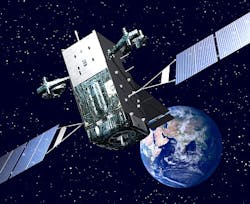Lockheed Martin to beef-up cyber security for SBIRS electro-optical satellite surveillance system
LOS ANGELES AIR FORCE BASE, Calif. – Missile-defense experts at Lockheed Martin Corp. will beef-up cyber security capabilities of a U.S. electro-opticalsatellite surveillance system under terms of a $15 million contract modification announced Tuesday.
Officials of the U.S. Air Force Space and Missile Systems Center at Los Angeles Air Force Base, Calif., are asking the Lockheed Martin Space Systems segment in Sunnyvale, Calif., to enhance the Space-Based Infrared System (SBIRS) ground system's cyber capabilities as an addition to a previous contract to Lockheed Martin for SBIRS full-scale development.
The SBIRS architecture consists of six satellites in geosynchronous orbit, hosted payloads in highly elliptical orbit (HEO), and ground hardware and software. The integrated system supports several missions simultaneously, while providing global persistent surveillance.
The SBIRS GEO satellites provide continuous early warning of ballistic missile launches and other tactical intelligence with infrared surveillance information.
In addition to the SBIRS ground station, several other high-profile U.S. military systems are being upgraded to enhance cyber security. President Donald Trump has said three of his defense priorities are cyber security, missile defense, and enhancing U.S. nuclear capabilities.
The SBIRS system enhances global missile launch-detection capability, supports the nation's ballistic missile defense system, expands the country’s technical intelligence gathering capacity, and bolsters situational awareness for warfighters on the battlefield, Lockheed Martin officials say.
Lockheed Martin is responsible for six SBIRS HEO payloads, six GEO satellites, and the ground system to receive, process, and disseminate the infrared mission data.
story continues below
The SBIRS team is led by the Infrared Space Systems Directorate at the Air Force Space and Missile Systems Center. Lockheed Martin is the SBIRS prime contractor, Northrop Grumman is the payload integrator. Air Force Space Command operates the SBIRS system.
The first SBIRS GEO spacecraft was declared operational in May 2013. The second orbiting SBIRS GEO satellite was declared operational in November 2013 eight months after launch.
The third SBIRS GEO satellite launched last January, and the fourth satellite in the SBIRS constellation is set for launch later this year.
Lockheed Martin is developing the next-generation SBIRS ground-control station, called Increment 2. Once operational, Increment 2 will increase SBIRS’ overall ability to manage complex, emerging threats while reducing Air Force operations and maintenance costs, Lockheed Martin officials say.
The SBIRS Increment 2 ground station consolidates three legacy ground system that operate from three different locations to manage the Defense Support Program (DSP), SBIRS Geosynchronous Orbit satellites, and Highly Elliptical Orbit hosted sensor payloads.
The Increment 2 ground station will consolidate those separate operations into one control station to command the global, persistent infrared surveillance provided by SBIRS.
On this contract modification Lockheed Martin will do the work in Sunnyvale, Calif., and should be finished by June 2019. For more information contact Lockheed Martin Space Systems online at www.lockheedmartin.com/us/ssc.html, or the Air Force Space and Missile Systems Center at www.afspc.af.mil.
Learn more: search the Aerospace & Defense Buyer's Guide for companies, new products, press releases, and videos

